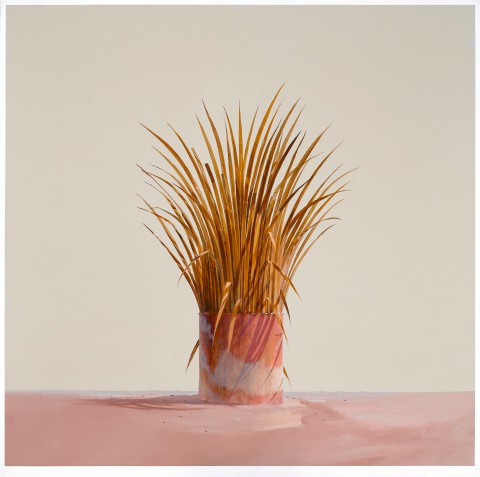OUTBACK GARDEN, 1979
TIM STORRIER
synthetic polymer paint on canvas
122.0 x 122.0 cm
signed and dated lower centre: Storrier ‘79
inscribed on stretcher bar verso: “STILL LIFE”
Australian Galleries, Melbourne (label attached verso)
Tolarno Galleries, Melbourne
The National Australia Bank Art Collection, acquired from the above in May 1979 (label attached verso)
The Seventies: Australian Paintings and Tapestries from the Collection of National Australia Bank, National Gallery of Victoria, Melbourne, 15 October – 28 November 1982 (as 'Camp II')
Lindsay, R., The Seventies: Australian Paintings and Tapestries from the Collection of National Australia Bank, The National Bank of Australasia, Melbourne, 1982, pl. 87, p. 100 (illus., as 'Camp II')
The Seventies: Australian Paintings and Tapestries from the Collection of National Australia Bank, Geelong Art Gallery, Victoria, 30 April - 29 May 1988 (as 'Camp II')
Colonial Garden, 1979, synthetic polymer paint on canvas, 152.0 x 152.0 cm, private collection
‘One of the compositional features of 1960s American Pop Art from which emerges the New Realism of the 1970s was the use of single icon images centrally places and isolated within the canvas to emphasise the ‘essence of the object’. Warhol’s paintings of soup cans elevated an everyday banal object to the states of a contemporary archetypal icon. Storrier… here employs a centrally placed image… yet although appearing to accurately render the appearance of the object rather than trying to distil the essence of the object/image, [he] nevertheless creates a surrealistic, unreal image. He has painted numerous desert landscapes in which the intense desert light bleaches out the colour and the shadows create almost abstract patterns. These deserts often have an implied narrative with unexplained relics, monuments, and enigmatic environmental curiosities. In Camp II [also known as Outback Garden, 1979] the can of weeds exists unexplained in an open empty desert and becomes a vehicle for patternmaking. There is an element of intriguing mystery in how these weeds came to exist in this can, for with their elegance they resemble a floral arrangement, however the rusted can suggests that they were mainly the result of water collecting in the discarded utensil.’1
1. Lindsay, R., The Seventies: Australian paintings and tapestries from the collection of National Australia Bank, National Bank of Australasia, Melbourne, 1982, p. 100
